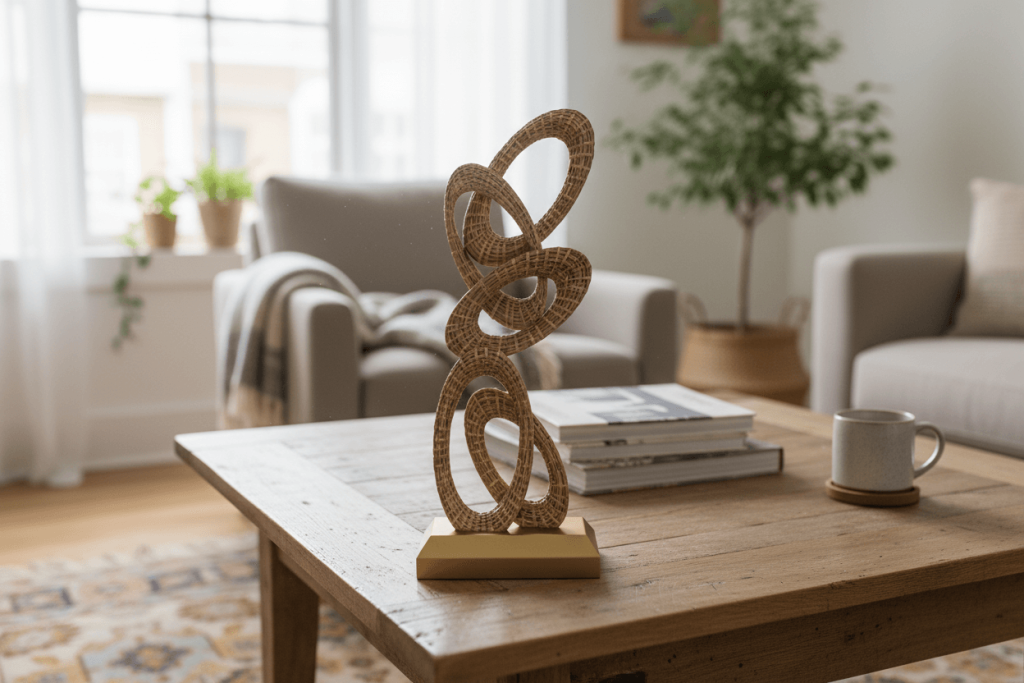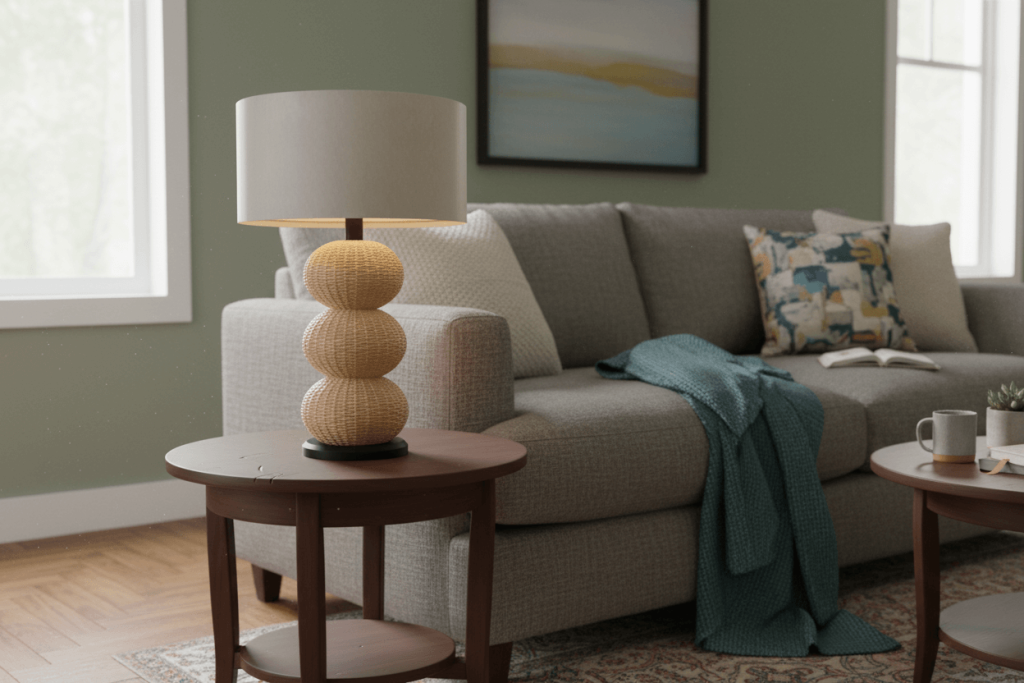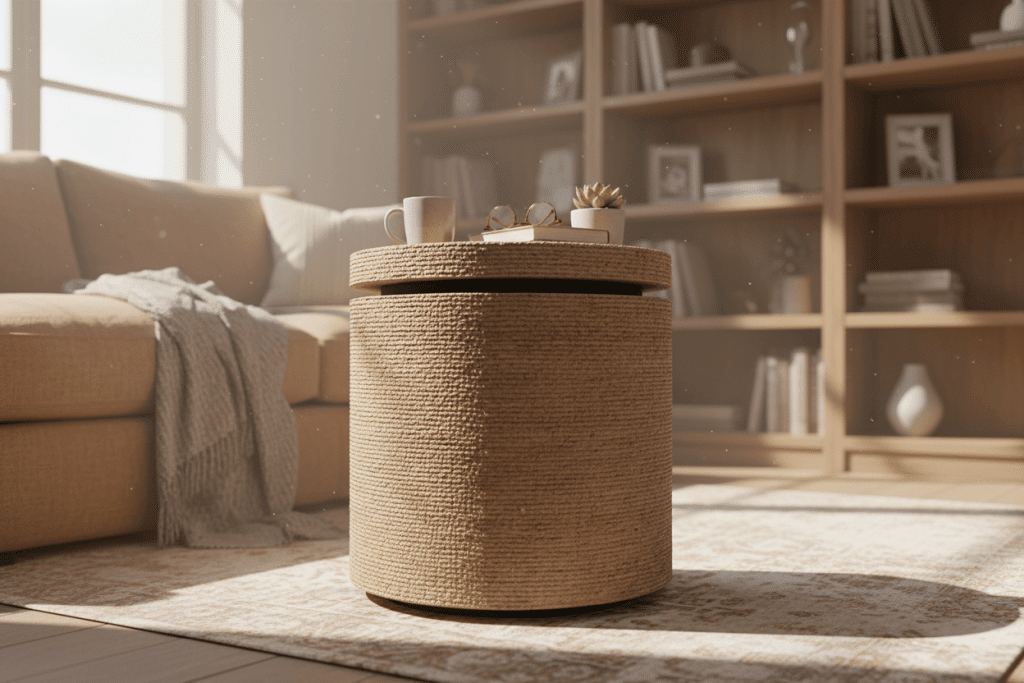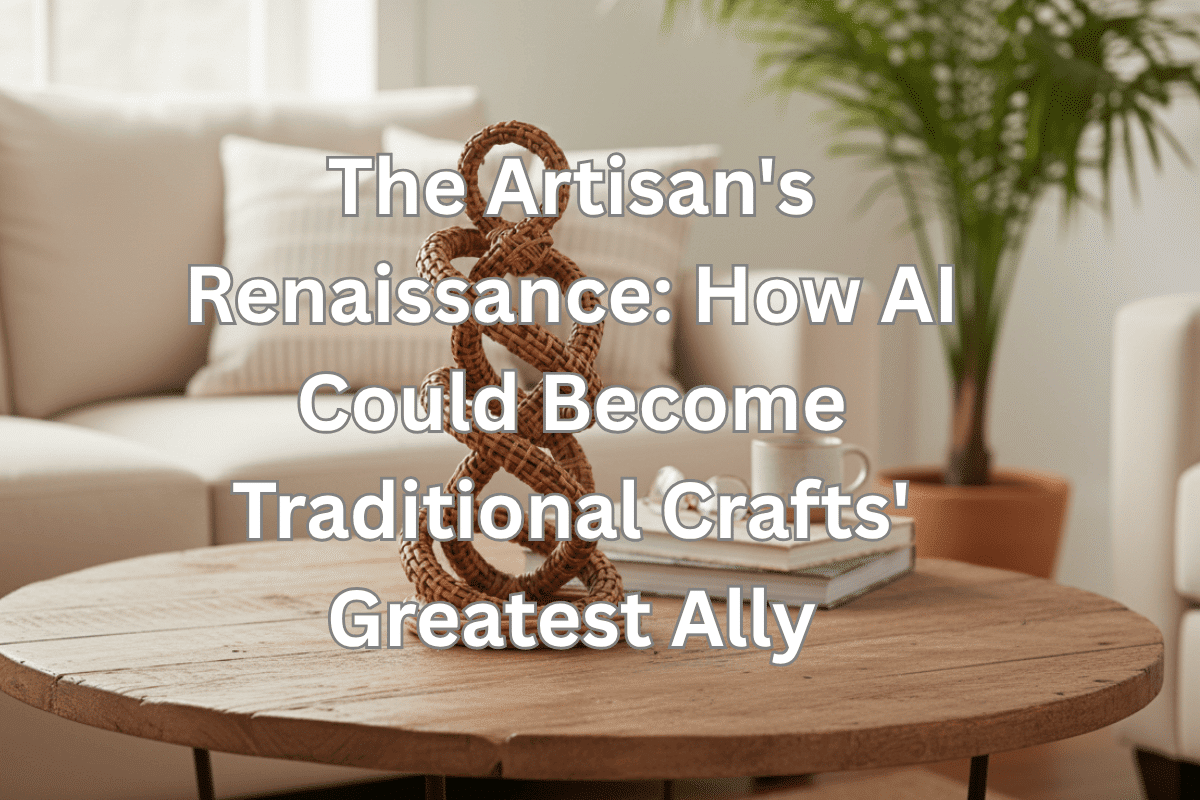Everyone says AI is coming for all our jobs, but what if it’s actually the greatest ally for traditional artisan crafts? While robots might seem like the antithesis of handmade beauty, we’re discovering surprising ways artificial intelligence could unlock new creative possibilities for the talented craftspeople we collaborate with. Prepare to have your perceptions of craftsmanship and technology completely reimagined.
Rather than replacing the centuries-old techniques passed down through generations in village workshops, AI could serve as a powerful tool to help these skilled artisans reach global markets and optimize their traditional methods. From helping our bamboo furniture makers analyze design trends while maintaining their cultural heritage, to enabling our ceramic artisans to explore new patterns that honor their traditions, AI could democratize access to capabilities previously available only to large corporations.
Table of Contents
- The Loom of the Past: A Craft Under Threat?
- The AI Palette: Tools, Not Replacements
- The Authenticity Advantage: What AI Can’t Replicate
- Tomorrow’s Atelier: Thriving in an Automated World
- The Artisan’s Legacy: Crafting Our Future
- Related Content
At Mondoro, we believe this technological partnership could amplify rather than diminish the irreplaceable human elements that make village-crafted goods so precious. The future isn’t about humans versus machines – it’s about traditional artisan communities thriving alongside AI to create something more beautiful than either could achieve alone.
The Loom of the Past: A Craft Under Threat?
For millennia, human hands have shaped clay, woven fibers, carved wood, and forged metal with an intimacy that machines have never been able to replicate. From the ancient pottery wheels of Mesopotamia to the intricate tapestries of medieval Europe, artisan crafts have been the backbone of human culture and commerce. These traditions carry within them not just techniques passed down through generations, but stories, cultural identity, and the irreplaceable touch of human creativity.

Artisan’s Working to Create Amazing Products
At Mondoro, we witness this rich heritage daily as we work alongside artisans in villages across Vietnam and other regions. These craftspeople don’t just create home decor and furniture; they preserve centuries-old techniques while adapting to modern market demands.
The relationship between artisan and craft has always been deeply personal. A master woodcarver in a Vietnamese village doesn’t just shape timber; they infuse each piece with years of experience, cultural heritage, and individual expression passed down through family lines.
The slight asymmetry in a hand-carved wooden bowl, the unique grain pattern highlighted by a village craftsperson’s careful attention, the subtle variations in hand-woven rattan furniture – these “imperfections” are actually the hallmarks of authentic human creation that we celebrate and nurture in our partnerships with rural artisan communities.
Yet today, this rich tradition faces what many perceive as its greatest existential threat: artificial intelligence. Headlines scream about AI replacing human workers across industries, and artisans aren’t immune to these concerns. The narrative is compelling and frightening – if machines can now create art, compose music, and even write poetry, what hope do traditional craftspeople in remote villages have?

Will AI Really Destroy Human Craft?
This perception of AI as an inevitable destroyer of human craft is understandable but potentially misguided. The fear stems from decades of automation that have indeed displaced many traditional manufacturing jobs. Factory workers have watched as assembly lines became increasingly automated, and now village artisans worry they’re next in line for technological obsolescence.
But here’s the central question we must grapple with: Can the unique value of human craftsmanship not only survive AI’s rise but actually thrive alongside it? What if, instead of viewing AI as a threat, we reimagined it as the most powerful tool artisans have ever had at their disposal – especially those working in traditional village settings where access to global markets and design trends has historically been limited?

The AI Palette: Tools, Not Replacements
The reality of AI’s relationship with artisan crafts is far more nuanced and promising than the doom-and-gloom narratives suggest.
At Mondoro, we’re exploring how AI can serve as a sophisticated set of tools that amplify, enhance, and unlock new possibilities for the village craftspeople we work with, rather than replacing their irreplaceable human creativity.
AI Can Help Support Artisans
Consider how we envision AI supporting our ceramic artisans in Vietnamese villages. These craftspeople have perfected their techniques over generations, creating beautiful pottery using methods passed down through families.
AI-powered design software could help them explore new geometric patterns for their glazes while respecting traditional aesthetics. The AI doesn’t create their pottery – their hands still shape every piece on the wheel, and their artistic vision guides every decision. Instead, the AI serves as a creative collaborator, generating pattern variations that incorporate both contemporary design trends and traditional Vietnamese motifs.

Similarly, our textile artisans who create beautiful home decor items could benefit from machine learning algorithms that analyze global color trends while preserving the cultural authenticity of their traditional patterns.
The AI could identify subtle color relationships and pattern structures that help these artisans adapt their centuries-old techniques to contemporary home decor markets without losing their cultural identity.
AI Can Help With Material Optimization
Material optimization represents another frontier where AI could prove invaluable to village artisans. Our furniture makers who work with sustainable bamboo and rattan could use AI to predict how different treatments and finishes will affect the durability and appearance of their pieces. This allows them to experiment with new approaches while minimizing waste – a crucial consideration both economically and environmentally for village-based operations.
These applications illustrate a fundamental shift in how we should think about AI in traditional crafts. Rather than human versus machine, we’re seeing the potential for “hybrid crafts” where artificial intelligence and human skill create something greater than the sum of their parts.
The AI provides computational power, pattern recognition, and market analysis capabilities that extend human perception and planning abilities. Meanwhile, the village artisan brings intuition, aesthetic judgment, cultural knowledge, and the irreplaceable skill of hand-crafting.
This collaboration could be particularly powerful in helping village artisans connect with global markets. AI can analyze international home decor trends, seasonal preferences, and consumer behavior patterns, providing insights that help rural craftspeople create products that resonate with global buyers while maintaining their authentic, handmade character.
At Mondoro, we believe this approach could revolutionize how village artisans engage with the global marketplace. Instead of being isolated from design trends and market demands, they could have access to the same analytical tools as major manufacturers, but with the added value of authentic, handcrafted production methods.
The Authenticity Advantage: What AI Can’t Replicate
While AI can assist in design, optimization, and market analysis, there remain fundamental elements of village artisan crafts that artificial intelligence simply cannot replicate – and likely never will. These irreplaceable human elements form the core of what makes the handcrafted goods we develop at Mondoro so valuable and sought-after.
AI Cannot Replace Generational Human Knowledge
First and foremost is the intuitive knowledge that comes from generations of hands-on experience. When a master furniture maker in a Vietnamese village selects a piece of bamboo, they’re not just looking at its size and shape – they’re reading the plant’s growth patterns, understanding its structural properties, and making countless micro-decisions based on knowledge passed down through family lines.
This intuitive understanding, built through years of tactile experience and cultural transmission, allows village artisans to work with natural materials in ways that no machine can replicate.
This intuition extends to the creative process itself. While AI can generate patterns and suggest color combinations based on mathematical relationships, it cannot replicate the creative spark that comes from a craftsperson’s cultural heritage and lived experience.
The woodcarver who incorporates traditional Vietnamese motifs into a modern furniture piece, or the weaver who creates patterns inspired by the natural landscape surrounding their village, is drawing from a well of cultural knowledge and personal experience that no algorithm can access.
Then there’s the story – perhaps the most powerful element that AI cannot replicate. Every handcrafted item we develop at Mondoro carries within it the narrative of its creation and the community behind it.
The generations of knowledge preserved in village workshops, the sustainable practices developed over centuries, the cultural traditions maintained and evolved through individual expression.

AI Cannot Replicate The Human Aspects
When someone purchases a hand-woven basket or carved wooden bowl through our partnerships, they’re not just buying home decor; they’re acquiring a piece of cultural heritage, a connection to the maker and their village community.
The beautiful imperfections that characterize village-made goods represent another irreplaceable element. The slight variations in a hand-woven textile, the unique tool marks on a carved sculpture, the subtle asymmetries in a hand-built ceramic piece – these “flaws” are actually features that speak to the human hands and cultural traditions behind the creation. They’re proof of authenticity in a world increasingly filled with perfect but soulless machine-made products.
Consumer behavior strongly supports this authenticity advantage. Despite the availability of mass-produced alternatives, demand for handmade, ethically sourced goods continues to grow.
At Mondoro, we see this trend reflected in our clients’ increasing interest in products with authentic backstories and sustainable production methods. The global handicrafts market is valued at over $700 billion and is projected to continue expanding, with consumers increasingly seeking products that align with their values of sustainability, authenticity, and social responsibility.
This demand isn’t just about aesthetics – it’s about connection and impact. In an increasingly digital world, people crave tangible connections to human creativity and skill, as well as the knowledge that their purchases support traditional communities and sustainable practices.
The knowledge that a real person in a Vietnamese village spent hours crafting an item by hand, using techniques passed down through generations, creates an emotional bond and sense of positive impact that no factory-produced item can match.
Tomorrow’s Atelier: Thriving in an Automated World
Rather than being displaced by AI, we believe the village artisans we work with at Mondoro can leverage artificial intelligence as their most powerful ally in building sustainable, thriving craft businesses. The key lies in understanding how to use AI strategically while maintaining the authentic human elements and cultural traditions that make their work valuable.
AI is revolutionizing craft education and skill transfer, which is particularly relevant for preserving traditional village techniques. Virtual reality systems could provide immersive training experiences, allowing young people in villages to learn from master craftspeople even when physical apprenticeships aren’t possible.
Machine learning algorithms could analyze video footage of master artisans at work, identifying subtle techniques and providing detailed feedback to students.
The implications for preserving and transmitting traditional craft knowledge are profound. Many village artisan techniques exist only in the hands and minds of aging masters. AI-powered documentation systems could capture not just the visual aspects of these techniques, but also the subtle pressures, timing, and decision-making processes that make the difference between amateur and expert work.
At Mondoro, we see this as crucial for ensuring that traditional Vietnamese and other regional craft techniques don’t disappear with the current generation of masters. AI could help us create comprehensive digital archives of traditional methods while simultaneously helping young artisans learn these techniques more effectively.

Perhaps most excitingly, we’re beginning to envision entirely new applications of traditional craft techniques born from AI collaboration.
Village artisans could create furniture and home decor that incorporates traditional methods with AI-optimized designs for specific functions – bamboo furniture with structures optimized for maximum strength and minimal material use, or ceramic pieces with traditional glazing techniques applied in patterns designed for optimal visual impact in modern homes.
The Artisan’s Legacy: Crafting Our Future
As we look toward the future, it becomes clear that the relationship between artificial intelligence and traditional village crafts isn’t a zero-sum competition – it’s a symbiotic partnership with the potential to create something far more beautiful and meaningful than either could achieve alone.
At Mondoro, we believe the enduring value of human creativity and traditional skill in a technologically advanced world isn’t diminished by AI; it’s highlighted and amplified. In a future where machines can produce perfect replicas of almost anything, the slight tremor in a hand-carved line, the unique way a village craftsperson solves a design challenge, the cultural knowledge embedded in traditional techniques – these become more precious, not less.
We’re witnessing the potential birth of a new renaissance in village artisan crafts, one where ancient techniques are enhanced by cutting-edge technology to create works of unprecedented beauty and complexity.
The potter in a Vietnamese village who could use AI to explore new glaze formulations but still throws each piece by hand using techniques learned from their grandmother.
The weaver who could employ machine learning to analyze global home decor trends but creates each textile with traditional looms passed down through generations.
The furniture maker who could use computational design to optimize joint structures but still shapes each piece with hand tools and methods perfected over centuries.
This isn’t about technology replacing tradition – it’s about tradition evolving and adapting, as it always has throughout history. The same spirit of innovation that led ancient craftspeople to develop new techniques and tools is now leading contemporary village artisans to potentially embrace AI as their newest implement, with companies like Mondoro serving as bridges between traditional craft communities and modern technology.

The responsibility now lies with all of us to support this evolution. We can choose to purchase handmade goods from village artisans, even when cheaper alternatives exist.
You can seek out companies like Mondoro that work directly with traditional craft communities and learn about their processes.
We can encourage young people to explore craft traditions, knowing that these skills will be more valuable, not less, in an AI-enhanced world.
At Mondoro, we’re committed to being part of this positive transformation. Our work with village artisans isn’t just about creating beautiful home decor and furniture – it’s about preserving cultural heritage, supporting traditional communities, and demonstrating that authentic craftsmanship has a vital place in our technological future.
The future we’re crafting – quite literally – is one where the warmth of human creativity and the power of artificial intelligence combine to create objects and experiences of unprecedented beauty and meaning.
In this future, the village artisan’s workshop isn’t replaced by the robot factory; instead, it becomes a space where ancient wisdom and cutting-edge technology dance together in the hands of skilled creators who carry forward the traditions of their ancestors.
The greatest threat to traditional village crafts isn’t artificial intelligence – it’s the failure to embrace the possibilities that AI offers while holding fast to the irreplaceable human elements and cultural traditions that make handmade goods so precious.
Village artisans who understand this balance, supported by companies committed to their success, will not just survive the AI revolution; they’ll lead it, creating a future where technology serves humanity’s deepest creative impulses and cultural preservation.
As we stand at this crossroads between tradition and innovation, we have the opportunity to write a new chapter in the story of human creativity and cultural preservation. It’s a chapter where the ancient art of making things by hand doesn’t disappear but instead finds new expression, new possibilities, and new relevance in our rapidly changing world, with village communities at the center of this renaissance.
The loom of the past is being rewoven with threads of artificial intelligence, creating a tapestry more complex and beautiful than anything we’ve seen before.
The village artisan’s legacy isn’t ending – it’s just beginning its most exciting chapter yet, and at Mondoro, we’re honored to be part of this transformation.
For more information about Mondoro’s work with artisans, visit us at Mondoro.com.
If you are interested in seeing how Mondoro can help you, we would love to talk to you about how we can help you and be part of your global supply chain.
Find out more about how Mondoro can help you create, develop, and manufacture excellent home decor and home furniture products – don’t hesitate to contact me, Anita. Check out my email by clicking here or become a part of our community and join our newsletter by clicking here.
Mondoro gives out a FREE Lookbook to anyone interested. You can receive a copy of our latest Lookbook by clicking here.
Listen to our Podcast called Global Trade Gal. You can find it on all major podcast platforms. Try out to listen to one of our podcasts by clicking here.
Subscribe to our Mondoro Company Limited YouTube Channel with great videos and information by clicking here.
Related Content
What Handicraft Products Is Vietnam Known For?
Vietnam is known for its Vietnamese lacquerware production and has a long history in manufacturing ceramics and porcelain. It also has a long history of basket weaving and silk weaving, along with embroidery and horn production.
You can learn more by reading What Handicraft Products Is Vietnam Known For? by clicking here.
How Does Poverty Affect Children’s Education? Helping Students in Vietnam
Children who are struggling with poverty usually have a harder time with education. This lack of education can lead to lifelong struggles and poverty, so education for children is essential.
There are many ways that education can help a child, such as with their nutritional needs, health, disease control, gender equality, and helping the children eventually break out of the poverty cycle.
By clicking here, you can learn more by reading our blog, How Does Poverty Affect Children’s Education? Helping Students in Vietnam by clicking here.
Why Home Decor Matters? 10 Reasons Why Home Decor is Important
Home Decor matters since how our home is decorated can and will affect all aspects of our lives. Our homes show the world who we are and what is important to us. Our home decor can affect our physical and mental well-being. Our homes are also gathering places for our families, friends, and loved ones.
You can learn more by reading our blog, Why Home Decor Matters? 10 Reasons Why Home Decor is Important by clicking here.

